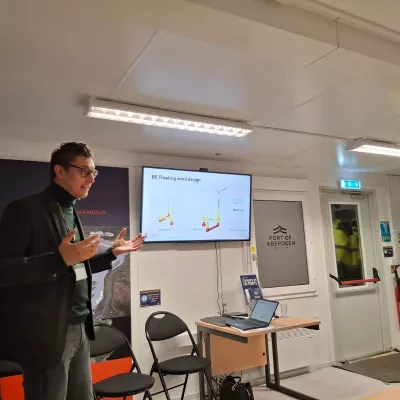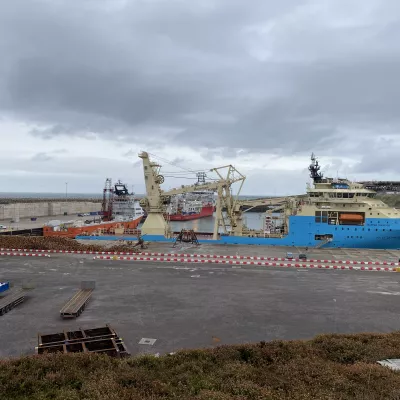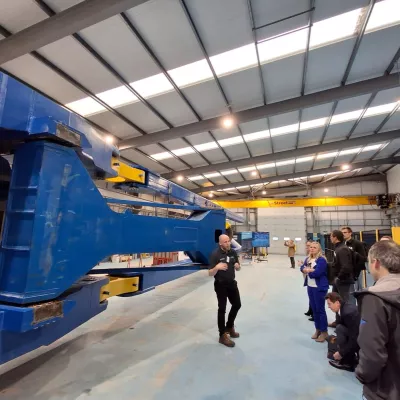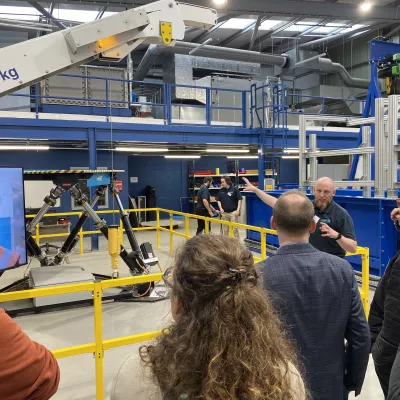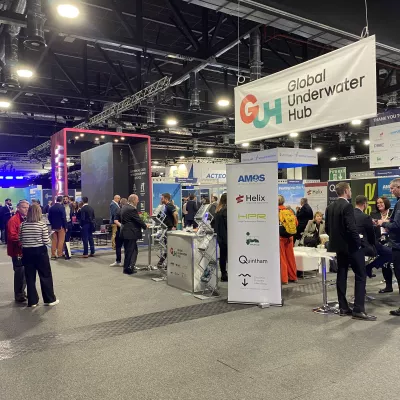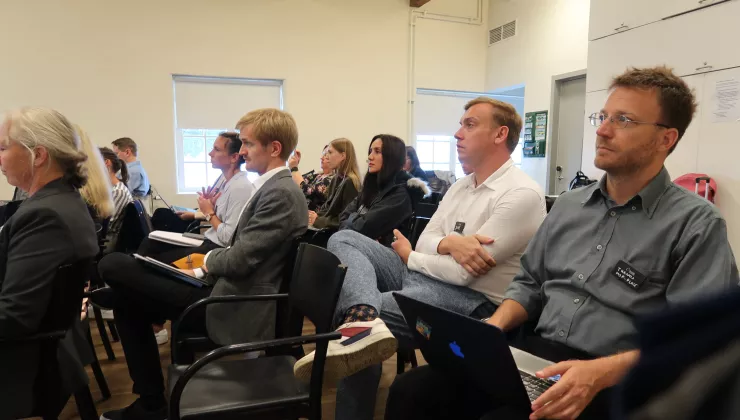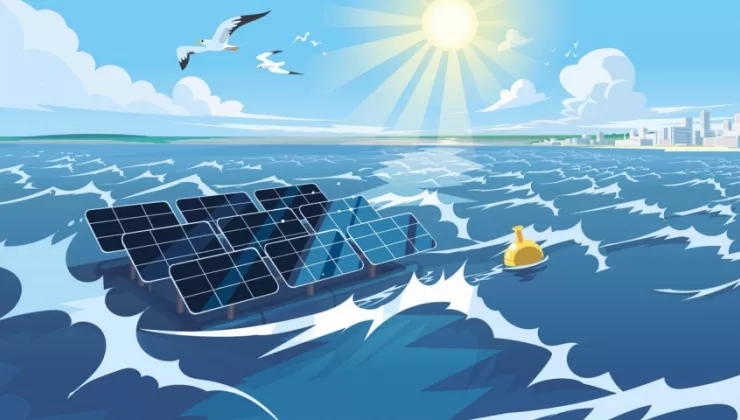Floating offshore wind and dismantling expertise in Scotland
With around 40GW of offshore wind capacity in the pipeline, Scotland is one of the largest offshore wind markets in the world. There are currently 8 bottom-fixed wind farms in operation, representing 2.9GW of capacity. Several more are under development, including in deeper water zones.
Scotland is also a pioneer in floating wind farms, boasting two operational demonstration farms: Kincardine (off the coast of Aberdeen) and Hywind Scotland. Two recent leasing rounds have resulted in floating wind projects with a capacity of 17.8GW and 5GW respectively.
Flemish dimension
A number of Flemish companies are involved in some of these projects:
- Elicio, together with BW Ideol and BayWa r.e., has acquired the rights to develop a floating offshore wind farm with an estimated capacity of 1GW 75 km northeast of Fraserburgh (Buchan Offshore Wind).
- DEME Group, Aspiravi and Qair have joined forces as Thistle Wind Partners, and this group is currently developing 2GW of floating and bottom fixed offshore wind capacity at their ScotWind lease locations: the Ayre Offshore Wind Farm (Orkney) and the Bowdun Offshore Wind Farm (Aberdeenshire).
- Bridon-Bekaert has a mooring production facility in Aberdeen.

Chances and challenges
Scotland is one of the contenders to be the first region in the world to have a large commercial floating wind farm in operation. Other contenders include the Celtic Sea and South Korea.
One of the challenges for the massive roll-out of offshore wind in Scotland is connecting to and strengthening the electricity grid to transport the energy produced to major consumption centres further south in the UK and Europe.
Group trip
With the support of Flanders Investment & Trade, Blue Cluster organised a group trip to Aberdeen for its members and partners to gain a better understanding of the current state of affairs in Scotland.
The participants visited the National Decommissioning Centre and the FLOWIC test centre of ORE Catapult. There was also a meeting with Principle Power and a networking session organised by Aberdeen Renewable Energy Group (AREG) with presentations by Flotation and Beam.
The programme also included a visit to Floating Offshore Wind 2024, one of the largest floating wind energy trade fairs in the world. This event was an initiative of RenewableUK and Scottish Renewables, and took place in Aberdeen.
Learn more about the different visits
National Decommissioning Centre
The National Decommissioning Centre (NDC) was established in 2019 with support from the Net Zero Technology Centre and the University of Aberdeen. Since then, Scotland, the City of Aberdeen and the University have invested almost £25 million in buildings, facilities, staff and PhD students. Originally established to be a world leader in R&D for oil and gas decommissioning, the scope has broadened to include offshore renewables and nuclear.
In the area of decommissioning, the NDC carries out research into emissions, scenario modelling, cost analysis, automation, decision tools, etc. In addition to publicly funded research (including within the Interreg project Decom Tools), contract research is also carried out on behalf of companies such as Chevron, Shell and the Nuclear Decommissioning Authority (NDA).
The floating wind research programme is being carried out in partnership with Offshore Renewable Energy (ORE) Catapult (see below) and concerns the organisation of maritime operations, port infrastructure requirements, the environmental impact of wind farms and the improvement of anchor systems.
The NDC’s Virtual Reality dome is impressive, a 300° immersive environment that can be used to simulate, test and optimise complex maritime operations. This enables engineers to devise scenarios for challenges they may face when building future floating wind turbines. For example, the installation of anchors for the turbines.
In addition, the NDC has supercomputer capacity, a hyperbaric pressure tank, powerful industrial lasers, a freshwater and saltwater pool, a climate chamber, a vibration table, etc.
Floating Wind Innovation Centre (FLOWIC)
The national Floating Wind Innovation Centre (FLOWIC), a division of the Offshore Renewable Energy (ORE) Catapult focused on floating wind, is located just down the road in Aberdeen’s new Energy Transition Zone.
FLOWIC aims to accelerate the commercialisation of floating offshore wind energy through the testing and validation of new technologies and products. The focus is on anchoring, dynamic cables, installation and maintenance.
Our group attended an “Open Day”, where we were able to visit the new large-scale dynamic cable test rig, an anchor test rig and the hexapod platform, which is used to simulate the motions that floating structures encounter.
Principle Power
Thanks to the efforts of the local FIT office, a meeting was arranged with Greg Campbell-Smith, Commercial Vice-President at Principle Power. Principle Power is the project developer of the Kincardine Offshore Wind Farm off the coast of Aberdeen, a demonstration farm of 5 floating wind turbines with a total capacity of 50 MW, of which the first turbine was installed in 2018.
Current situation
Principle Power’s main asset is their patented portfolio of floating foundation designs (WindFloat), the first prototype of which was demonstrated off the coast of Portugal in 2011. These foundations can be combined with all commercially available wind turbines, and their energy yield is 1-2.5% higher due to the active ballast system.
In addition to the Kincardine farm, Principle Power has 3 floating turbines operational in Portugal. The third generation will be installed in the near future at Les Eoliennes Flottantes du Golfe du Lion in France (30 MW) in partnership with Ocean Winds.
Future plans
Principle Power has over 7 GW of projects in the pipeline. In general, South Korea is the furthest along in the development of commercial floating wind farms (2 FEEDs, news on this early 2025) followed by Scotland, the Celtic Sea, Italy and the West Coast of the US. Greece, Norway and Sweden are lagging behind.
In the meantime, Principle Power is working on the 4th generation of floating wind foundations combined with turbines of 15+ MW: the so-called WindFloat T (with tube structure) and WindFloat F (with flat panels). For both models, a design is available with a central tower (=stiff-stiff design) that is less susceptible to fatigue than the design with a tower on one of the corners (=soft-stiff design).
The designs achieve a cost saving of 32%, combined with the use of local shipyards, standardized elements and modular construction.
Challenges
After the presentation, there was a discussion with the group about the challenges of (floating) offshore wind:
- Grid connection: together with Tractebel, Principal Power is working on a design with decentralised production of hydrogen (Dolphyn) so that wind farms can operate independently of the electricity grid.
- Corrosion, e.g. pitting corrosion:
- Is investigated in the Joint Industry Project (JIP) for Seawater Corrosion of wire Rope and mooring Chain (SCORCH)
- Principle Power is currently working on a digital twin with Ocean Winds regarding stress analysis
- Extending the design period to 25-30 years, including through monitoring (24Sea – Wölfel)
- Erosion of cables
- Circularity & CO2 footprint
- Local content in Scotland: Technip, Oceaneering, Balmoral
Flotation Energy
During a B2B session organised by Aberdeen Renewable Energy Group (AREG), the group received an update on the Green Volt floating wind farm from Steven Penny, Senior Supply Chain Advisor.
The 560 MW Green Volt wind farm is a project by Flotation Energy (part of TEPCO Japan) and Vårgrønn. The latter is a Norwegian developer with ENI as a shareholder, part owner of the Dogger Bank wind farm.
The Green Volt project was the first to obtain all permits and grid connection, and since September also a CfD (Contract for Difference). It is on track to become the world's first operational commercial floating wind farm in 2029.
What is special is that this concession was obtained under the INTOG leasing round, in other words the first goal of the wind farm is the decarbonization of oil and gas production.
The project is currently in the procurement phase, in which they opt for fewer (and larger) contracts. The offshore substation will be built with a fixed structure, as there are no dynamic cables available that are large enough.
Beam
Beam is a survey & subsea company active in offshore wind, oil & gas and defense. In the field of decommissioning, Beam offers services regarding preliminary investigations into the integrity and condition of underwater installations (for example via 3D scanning) and the marine environment. In addition, the company can provide specific services to identify and remove parts and waste underwater.
Floating Offshore Wind-beurs en conferentie
On the last day of the mission, the group took part in the Floating Offshore Wind exhibition and conference in Aberdeen. With 180 stands and 2,400 visitors, this is one of the largest floating wind events in Europe.
At the exhibition, a visit was made to the stands of Flemish companies in the industry:
- Bridon-Bekaert in collaboration with Bexco
- Sarens
- Thistle Wind Partners, with representation from DEME
- Maridea BV, which markets the Moray Base, a floating foundation for wind turbines, in collaboration with Multi.engineering

